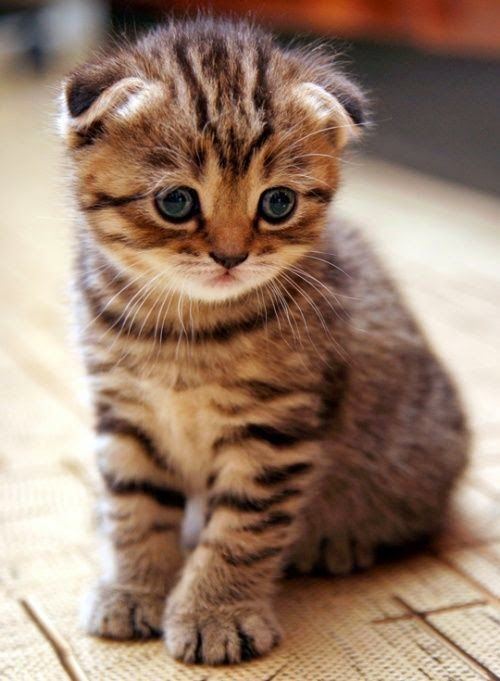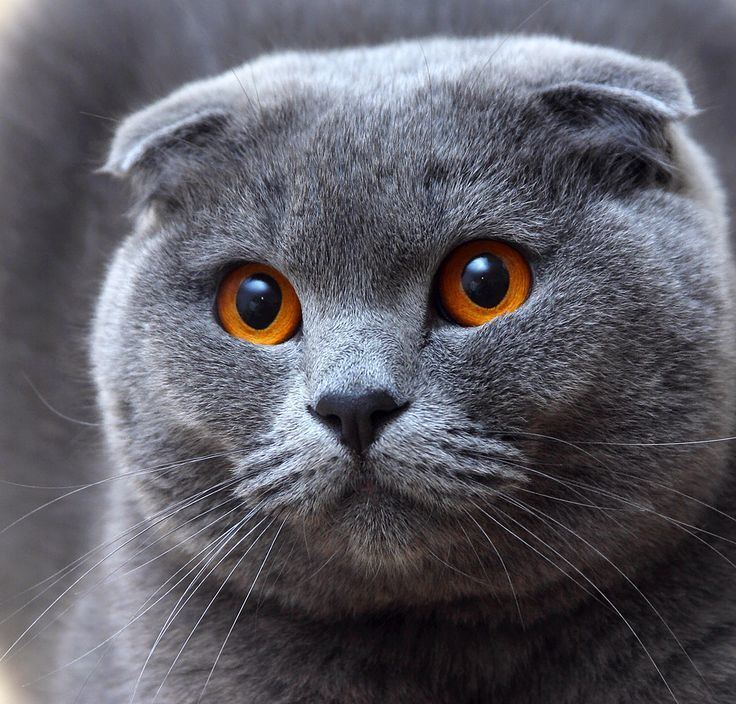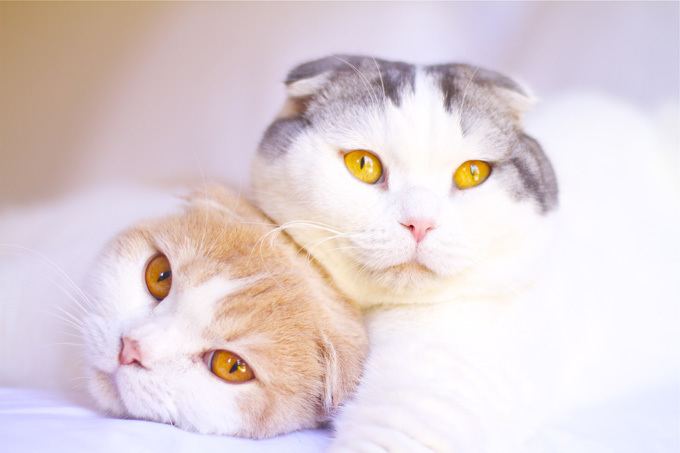Other names Scot Fold TICA standard ACFA/CAA standard Rank Breed | CFA standard AACE standard Scientific name Felis catus Higher classification Cat | |
 | ||
Similar British Shorthair, Munchkin cat, Russian Blue, American Shorthair, Persian cat | ||
The Scottish Fold is a breed of domestic cat with a natural dominant-gene mutation that affects cartilage throughout the body, causing the ears to "fold", bending forward and down towards the front of the head, which gives the cat what is often described as an "owl-like" appearance.
Contents
- Origin
- Acceptance
- Popularity
- Ears
- Body
- Coat
- Temperament
- Habits
- Genetics
- Health
- Osteochondrodysplasia
- Biography
- In popular culture
- Internet media
- References

Originally called lop-eared or lops after the lop-eared rabbit, Scottish Fold became the breed's name in 1966. Depending on registries, longhaired Scottish Folds are varyingly known as Highland Fold, Scottish Fold Longhair, Longhair Fold and Coupari.

Origin

The original Scottish Fold was a white barn cat named Susie, who was found at a farm near Coupar Angus in Perthshire, Scotland, in 1961. Susie's ears had an unusual fold in their middle, making her resemble an owl. When Susie had kittens, two of them were born with folded ears, and one was acquired by William Ross, a neighbouring farmer and cat-fancier. Ross registered the breed with the Governing Council of the Cat Fancy (GCCF) in Great Britain in 1966 and started to breed Scottish Fold kittens with the help of geneticist Pat Turner. The breeding program produced 76 kittens in the first three years—42 with folded ears and 34 with straight ears. The conclusion from this was that the ear mutation is due to a simple dominant gene.

Susie's only reproducing offspring was a female Fold named Snooks who was also white; a second kitten was neutered shortly after birth. Three months after Snooks' birth, Susie was killed by a car. All Scottish Fold cats share a common ancestry to Susie.
Acceptance

The breed was not accepted for showing in Europe and the GCCF withdrew registrations in 1971 due to crippling deformity of the limbs and tail in some cats and concerns about genetic difficulties and ear problems such as infection, mites, and deafness, but the Folds were exported to America and the breed continued to be established using crosses with British Shorthairs and American Shorthairs. Since the initial concerns were brought, the Fold breed has not had the mite and infection problems, though wax buildup in the ears may be greater than in other cats.
Popularity

The rare distinctive physical traits of the breed, combined with their reputation as unusually loving companions, make Folds highly sought-after pets and Fold kittens typically cost considerably more than kittens of more common breeds.
Ears

All Folds are born with straight, unfolded ears, and those with the Fold gene will begin to show the fold usually within about 21 days. The kittens that do not develop folded ears are known as Straights. The original cats only had one fold in their ears, but due to selective breeding, breeders have increased the fold to a double or triple crease that causes the ear to lie totally flat against the head.
The breed's distinctive folded ears are produced by an incompletely dominant gene that affects the cartilage of the ears, causing the ears to fold forward and downward, giving a cap-like appearance to the head. Smaller, tightly folded ears set in a cap-like fashion are preferred to a loose fold and larger ear. The large, round eyes and rounded head, cheeks, and whisker pads add to the overall rounded appearance. Despite the folded ears, folds still use their aural appendages to express themselves—the ears swivel to listen, lay back in anger and prick up when the treat bag rustles.
Body
The Scottish Fold is a medium-sized cat, with males typically reaching 4 to 6 kg (9–13 lb), females 2.7–4 kg (6–9 lb). The Fold's entire body structure, especially the head and face, is generally rounded, and the eyes large and round. The nose will be short with a gentle curve and the cat's body well-rounded with a padded look and medium-to-short legs. The head is domed at the top, and the neck very short. The broadly-spaced eyes give the Scottish Fold a "sweet expression".
Coat
Scottish Folds can be either long- or short-haired, and they may have nearly any coat color or combination of colours (including white)
Temperament
Scottish Folds, whether with folded ears or with normal ears, are typically good-natured and placid and adjust to other animals within a household extremely well. They tend to become very attached to their human caregivers and are by nature quite affectionate. Folds also receive high marks for playfulness, grooming and intelligence. These animals like to be outdoors and enjoy outdoor games and activities very much. Loneliness is something they heavily dislike and which makes them feel depressed. It is also common for Scottish Folds to be stubborn.
Habits
Folds are also known for sleeping on their backs. Scottish Folds typically have soft voices and display a complex repertoire of meows and purrs not found in better-known breeds. Folds are also known for sitting with their legs stretched out and their paws on their belly. This is called the "Buddha Position".
Genetics
An early study suggested that the fold is inherited as an autosomal dominant trait. A later study suggested an incomplete dominance. A cat with folded ears may have either one (heterozygous) or two copies (homozygous) of the fold gene (Fd). A cat with normal ears should have two copies of the normal gene (fd).
Mating a homozygous fold with any cat will produce all folds, but because homozygous folds are prone to severe health issues, breeding for them is generally considered unethical. A homozygous to normal mating will produce only heterozygous folds but presumably in ethical breeding programs, there will be no homozygous cats available to breed from.
The only generally accepted breeding gives a 50% chance of producing heterozygous folds and 50% chance of producing normals.
There is suspicion that some non-fold litters are genetically heterozygous folds but because of very low expression of the gene, appear to be straight-eared. Such kittens may develop folded ears initially which then straighten back out. Because of this there are suggestions by some breeders to avoid mating Folds with straight-eared Scottish Folds but only use British Shorthairs (BSH) as outcross. If Scottish Shorthairs are to be used, they should be test mated to a BSH to make sure that they are not genetically folds. If such apparent straight-eared cats are mated with a fold, there is a 75% chance of folds(25% homozygous folds, 50% heterozygous folds) and 25% chance of straight ears.
Health
The typical lifespan of a Scottish Fold is 15 years.
Scottish folds are susceptible to polycystic kidney disease (PKD) and cardiomyopathy.
Osteochondrodysplasia
Osteochondrodysplasia (OCD) is a developmental abnormality that affects cartilage and bone development throughout the body. This condition causes the fold in the breed and in studies conducted so far, all folded cats are affected by it. Homozygous folds are affected by malformed bone structures and develop severe painful degenerative joint diseases at an early age. This condition also affects heterozygous folds, but usually to a much lesser extent and at a later age. Some will be asymptomatic.
While ethical breeders breed Fold/non-fold and not Fold/Fold (in the same way Munchkins are bred) to avoid producing homozygous folds, because heterozygous folds can also develop progressive arthritis of varying severity, some researchers recommend abandoning the breeding of folded cats entirely. For this reason the breed is not accepted by either the Governing Council of the Cat Fancy or the Fédération Internationale Féline.
CFA breeders have stated that using only fold to non-fold breeding has eliminated problems with stiff tails, shortened tails and bone lesions. In the FIFe discussion, the representative for British breeders claimed that they were not seeing the problem in their cats and that the study which showed that all heterozygous also have the condition had a small sample size. An offer of free X-rays was presented to 300 breeders to find a folded cat with healthy hind legs but it was never taken up. A similar offer was set up by the World Cat Federation together with researcher Leslie Lyons but there was also no response. FiFe stated that they will not consider recognizing Scottish Folds if breeders will not allow their breed to be scrutinized.
In a report on Scottish Folds, the Breed Standards Advisory Council (BSAC) for New Zealand Cat Fancy (NZCF) states that "Breeders may not have appreciated the strength of the evidence that heterozygous cats can and do develop [feline] OCD." While research shows that all heterozygous folds develop OCD, and anecdotal evidence shows that heterozygous folds can and do develop OCD, they do not show whether mildly affected parents are more likely to have mildly affected offspring. They also do not show what percentage of Folds are severely affected. The report states that there is not enough information to justify banning Scottish Fold matings but enough to justify a level of concern. Recommended guidelines includes:
